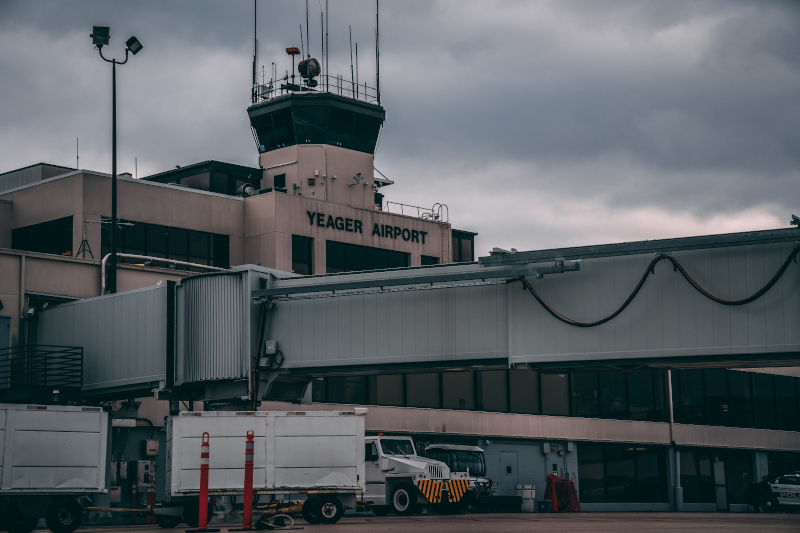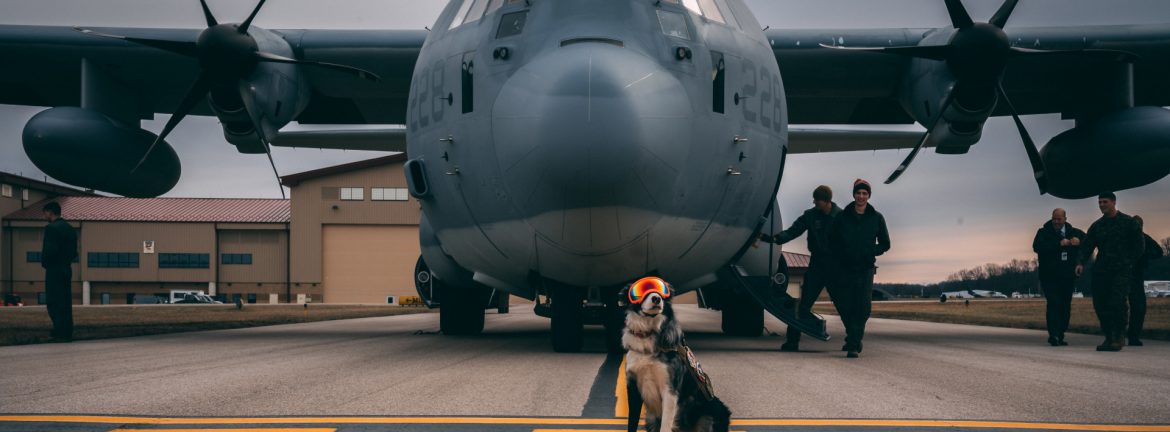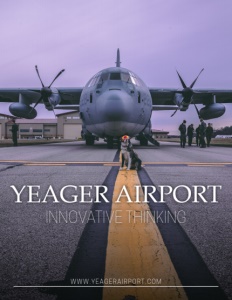Yeager Airport
Innovative thinking
Business View Magazine interviews representatives from Yeager Airport, as part of our series on regional American airports.
Yeager Airport is a commercial, military, and general aviation airport located three miles east of downtown Charleston, in Kanawha County, West Virginia. The Airport sits on a hilltop, over 300 feet above the valleys of the Elk and Kanawha Rivers. It covers 767 acres and has one asphalt runway, 5/23, which is 6,715 X 150 feet.
Originally called the Kanawha Airport, the facility opened in 1947. “They had to level three mountaintops and fill the valleys in between to build the Airport,” recounts Airport Director, Nick Keller. “The first tenant was the West Virginia Air National Guard, and then we had commercial air service from American, Capitol, and Eastern; Piedmont came in 1948. We went into the jet age in 1968 with our first jet service from United; then Piedmont and US Air, through the 1980s. Piedmont went away and US Air was the dominant carrier here until 9/11. Today, we have Delta, American, United, and Spirit, with nonstop flights to seven major airports.”

In 1985 the Airport was renamed for then-Brigadier General Chuck Yeager, a native of nearby Lincoln County who piloted the world’s first supersonic flight in the Bell X-1. Today, Yeager Airport is owned by the Central West Virginia Regional Airport Authority, which has about 85 full-time and 30 part-time employees. In 2008, Yeager’s Governing Board voted to close the Airport’s secondary Runway 15/33, to allow construction of two new hangars and ramp space for four more C-130s to be based at the Air National Guard facility. In addition to about 60 home-based general aviation aircraft, Yeager is also home to Hangar 9 Aviation, a flight school, and Capital Jet Center, the Airport’s FBO.
“Capital Jet Center bought out the lease of the previous FBO and operates as another department within the Airport Authority,” says Keller. “We really like that because, through the Airport Authority, we control the fuel prices, but more importantly, we control the customer experience.” The Jet Center is open 24 hours a day and its services include refueling, de-icing, baggage and cargo handling, as well as serving as a U.S. Customs Port of Entry. According to its Assistant Manager, Andrea Tracewell, future plans for the FBO include building a new, stand-alone customs building and adding an avionics shop with an onsite A&P (Airframe and Powerplant) mechanic.
Having lower fuel prices, according to Keller, helps make Yeager more attractive to the corporate jet and general aviation traffic it wants to attract. “We want to be a mecca for general aviation, so that’s one of the reasons we took over the FBO. And we’ve got professional employees who are dedicated to customer service. It takes 400 hours for a line service technician to get through the NATA Safety First and NATA Customer Service training. Epic Fuels, our vendor, provides some training, as well, so we’ve really spent a lot of time and money upgrading the facility.” Regarding commercial traffic, Keller says that even though Yeager is the largest airport in West Virginia, with the most air service, it does leak about 20 percent of its commercial passenger traffic to Pittsburgh, Cincinnati, and Columbus, all of which are about three to four hours away. “So, we get a bit of leakage,” he admits, “but, overall, it’s not very much.”
As is the case with all airports, there is a wide range of construction and rehabilitation projects just completed, ongoing, and planned at Yeager. “There has been about $30 million worth of construction in the last three years,” Keller reports. “We have a major runway safety project that cost $24 million that just finished last August. We received a $3.4 million FAA grant, last year, for the construction of an access road to general aviation. We used to have a crosswind runway; that was closed down in 2012 for various reasons. The runway became a taxiway. We have about 25 acres of land that aren’t being utilized, so we thought if we can put a road to extend general aviation out, the road opens up those acres.
“Right now, we’re doing a drainage improvement project – that’s a $2.3 million AIP (Airport Improvement Program) project to repair some drainage around the Airport and also put in a retaining wall in one sector of the runway safety area,” he continues. “Being on top of a mountain in West Virginia, drainage is always something that has to be controlled. We’re also doing a $1.5 million security project – upgrading access control with cameras. And we just finished a solar project – we have solar panels installed on one of our larger parking garages. That was about a $3.8 million project; it decreases our electric bill by about $50,000 a year. It’s actually the largest solar array in the State of West Virginia.
“Coming up in the next three years is a major runway rehabilitation – that’s going to be a $25 million project phased in over three years. The runway hasn’t been rehabbed since 2003, so it’s past time. It’s going to be some real rehab, not just an overlay of asphalt. There’ll be some new runway centerline lights, and new edge lighting, all going to LED.
“We just finished up our Master Plan and the long-term goal is to do a standard safety area project for the runway. Currently, within the confines of the Airport, we do not have standard runway safety areas; we have a 500-foot threshold on Runway 5/23, and then we have an EMAS (Engineered Materials Arrestor System) bed on 5. The EMAS bed is about 300 feet long, but the width is only about 200 feet. A standard runway safety area is 1,000 by 500 feet. Given our terrain, we have heavily advocated for the FAA to pay for standard safety areas. And the way we’d do that is go off the end of Runway 23 and do a dirt fill – about 20 million cubic yards of dirt – into this valley that we own, from a county park adjacent to the Airport. So, we would have the runway safety area project, and the FAA has agreed to allow us to have a 7,000-foot runway from its current 6,715, plus the safety areas. But, in addition to that, we’re actually advocating for a runway extension to go to 8,000 feet, plus the runway safety areas.

“One of the good things about filling the valley in is that part of the area that we take dirt from would come down. So, we would actually get the ability to have another ramp at the end of Runway 23 that can be 50-100 acres for future use – hangars, an industrial park, whatever we want to do. So, there’s land on our property if this runway extension goes through that we can develop. I think the timing would be right, because the 25 acres that general aviation makes available now will be filled up, hopefully, in ten years. Then, we’d be looking to develop somewhere else, and this would be the logical place to do that.”
All of these current and potential improvements at Yeager are part of what Keller and his colleagues have laid out in their Airport Organizational Vision Statement, which envisions the Airport becoming the region’s and the state’s most important economic development engine. One important part of that vision is attracting more aerospace companies to the Airport, which would largely depend on an educated workforce capable of filling the jobs that new companies to the area would need to fill. The good news is that is getting ready to occur.
“We reached out to Marshall University,” Keller recounts. “It’s got about 13,000 students in Huntington, which is 50 miles away, and we proposed that they start a school of aviation to do pilot training, training for aviation management, and mechanics. I’m happy to say that Marshall was very interested and committed. They’re going to open a whole new school of aviation and build it at Yeager that will open in August 2021. We’re going to have a professional flight training Bachelors program and a Bachelors in aviation management. They project 200-300 students within five years of opening. Then, they’re going to open a second school of aviation at the Huntington Tri-State Airport for airplane mechanics. Tying the education component in to the 25 acres of land that we have due to the access road being built made the Marshall University school possible and it really sets us up well to have aerospace companies come into the region. So, everything that we’re doing here – the increases in the general aviation area, the aviation school, the longer runway – all tie into the vision of being the most important economic engine for the State of West Virginia.”
That type of innovative thinking and creativity at Yeager has had another interesting iteration, recently, as Keller and his colleagues have attempted to replace the decline in commercial and general aviation operations with more military uses at the Airport. He explains, “Through the FBO, we have a contract for military fueling. And that has led us down an exciting path. In the last year, we’ve had over a hundred different squadrons come to the Airport to fuel and train. There are coal mine sites in southern West Virginia, large surface coal mine sites; most of them have been reclaimed, but some are still active. And it kind of led into talking to the Navy and Marine Corps about what kind of training they have for their helicopters. We found out that they have to do a lot of landing in a dirt environment. And in North Carolina and Virginia, they don’t have anywhere to do that, so they’re flying out to Arizona or Idaho to do this training. And we thought, ‘What if we could utilize these coal mine sites, and use Yeager as a base of operations for the aircraft?’ And that’s been really successful; we’ve had multiple Marine Corps detachments coming here over the last year. They’re going out to the coal mine sites and they’re getting valuable training without having to fly out to Arizona. And it’s a great thing for our economy. When a detachment of Marines comes here, 30 or 40 of them are getting per diem and staying at our hotels.
“In addition, Capital Jet Center started ‘hot fueling’ military aircraft about a year-and-a-half ago. This is common practice in the Marines and the Navy; you refuel the aircraft with the engine still on. There’s a handful of civilian airport in the east coast that do it and we got trained by the Navy, and then the Marine Corps came in and did some training with our line service techs. So, we hot-fuel Army, Navy, and Marines. And that saves them a lot of time because they don’t have to shut down the aircraft. So, if they’re going out to a coal mine site and doing landings, they come back to Yeager and hot-fuel, which takes ten minutes versus an hour if they have to shut down and restart. Last May, we actually helped plan a Marine Corps infantry exercise at one of the coal mine sites. It was pretty interesting. They dropped off 125 Marines out in the woods, the aircraft came into Yeager, they hot-fueled, went back to North Carolina, came back four days later, picked up all the Marines, and hot-fueled again on the way back to North Carolina. And all that’s going to expand greatly in the next few years.”
The Airport also made their military guest feel right at home. “This past summer, we dedicated an office space to Woody Williams, who is a West Virginia native in the military, and the last surviving Medal of Honor recipient from World War II,” says Tracewell. “We had an office building that wasn’t being used for anything. We did some renovations to it and dedicated to him. It’s the Woody Williams Flight Operations Center and it’s connected to one of our available hangar spaces. So, when military units come to Charleston for multiple days to do training here, we offer that space to them so they’re not feeling as if they’re in the middle of our lobby and getting in people’s way. So it’s a complimentary space for them when they’re here training.”
Lastly, the team at Yeager hasn’t forgotten to pay attention to the next generation of pilots and airport personnel. “One of the things we have at the Airport is a dog name Hercules,” says Public Affairs Manager, Chris Williams. “We have issues, sometimes, with wildlife; we have a lot of birds up here, so his job at the Airport is chasing the birds off the runway. His second job is to go out into the community. Last month, he went to a career day at an elementary school and he interacts with the kids. At the Halloween Parade, this year, which is a mile-and-a-half long, everyone knew who Hercules was. It was pretty cool to see.”
AT A GLANCE
WHO: Yeager Airport
WHAT: A commercial, military, and general aviation airport
WHERE: Three miles east of downtown Charleston, in Kanawha County, West Virginia
WEBSITE: www.yeagerairport.com




